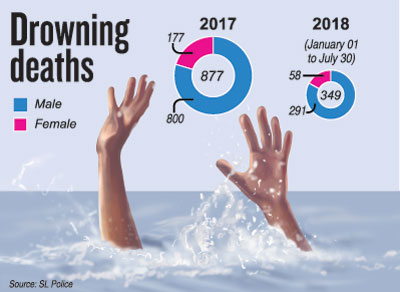News
Hike in drownings triggers steps to keep heads above water
Drowning incidents in Sri Lanka are on the rise. Just last week there were 9 instances with 11 deaths reported. Two 11-year-old schoolgirls bathing in the sea off Calido Beach, Kalutara, drowned last Saturday (21). On July 23, two students, both aged 16, drowned while bathing in the Dee Ella Oya at Veyangoda. They had skipped tuition classes and gone swimming with a group of friends. On the same day, three students, went rafting in the Velvettithurai sea, one drowned, and two were rescued when the raft capsized.
 On Tuesday (24), a garment factory worker in Avissawella, drowned while bathing in the Kelani Ganga with two others. Police also said three men drowned in three separate incidents in Maskeliya, Wadduwa and Avissawella On Friday (26) two residents of Passara and Udapussellawa, went missing while bathing in the Kalu Ganga at Wagawatta in Horana.
On Tuesday (24), a garment factory worker in Avissawella, drowned while bathing in the Kelani Ganga with two others. Police also said three men drowned in three separate incidents in Maskeliya, Wadduwa and Avissawella On Friday (26) two residents of Passara and Udapussellawa, went missing while bathing in the Kalu Ganga at Wagawatta in Horana.
According to Police statistics, there have been 349 deaths by drowning– 291 males and 58 females–this year between January 1 and June 30. Last year there were 877 deaths by drowning — 700 males and 177 females. The unofficial figures can be higher, Police said. While deaths by drowning keep increasing, the authorities responsible for measures to curb the growing incidents are inactive. A national policy in 2014, of countermeasures to reduce the number of drowning incidents, is gathering dust at the Disaster Management Ministry, and has yet to be presented for Cabinet approval.
Prof. Samath Dharmaratne of the Department of Community Medicine, University of Peradeniya, who had proposed a surveillance system to monitor swimming pools and beaches, said nothing came off the draft proposals for the last for years.
In 2017, at a symposium titled “Towards a National Plan on Drowning Prevention & Water Safety in Sri Lanka” sponsored by the Disaster Management Centre (DMC), the Sri Lanka Life Saving Association (SLLSA), Victoria Life Saving (VLS) and the Asia-Pacific Alliance for Disaster Management Sri Lanka (APADMSL), many deliberations were made including proposals to empower women and children with swimming skills and understanding the dangers when in water.
After four years of inaction from the DMC, the SLLSA has sought the assistance of the Tri-Forces to implement the programme. SLLSA advisor and past president Sanath Wijeratne said the Chief of Defence Staff, Admiral Ravindra Wijeguneratne has been receptive to the proposal, to bring a National Policy on prevention of drowning. He said the initial meeting was fruitful and he was hopeful that future meetings with the Admiral will result in the speedy implementation of the policy.
The plan, he said, will be modified in keeping with present needs. All stakeholders including the Tri-Forces, Police, Coastguard and Tourism Ministry will be consulted.
He said hitherto they had been working in isolation, but now they will join hands and find strength in numbers. The draft policy will be modified to look at areas that need improvement, including education of youth with special focus on schoolchildren, training and awareness sessions in prevention and safety programmes, along with signboards in high risk areas where people are tempted to jump in and take a dip. Drowning incidents usually occur in areas away from tourist- targeted spots, where there are no lifesavers or any supervision by adults.
Beach and pool safety also will be looked at, together with the Tourism authority. At present, pools in hotels and public places are manned by attendants who mainly know only to clean them. But regulations will require that these attendants know lifesaving skills to swim and administer first aid. They will be educated in keeping with international guidelines in the Sri Lanka context.
Also, a ‘Swim-for-Safety’ programme will be introduced where interested individuals will be taught to swim within 12 days. Underprivileged schools are being chosen and children and youths, along with parents will also be taught to swim. Risk areas include flood prone areas such as Ratnapura and Puttalam, Mr. Wijeratne said.
“Our goal is to teach everyone in Sri Lanka to swim, for safety,” he said.

